
Gobiidae or gobies is a family of bony fish in the order Gobiiformes, one of the largest fish families comprising more than 2,000 species in more than 200 genera. Most of gobiid fish are relatively small, typically less than 10 cm (3.9 in) in length, and the family includes some of the smallest vertebrates in the world, such as Trimmatom nanus and Pandaka pygmaea, Trimmatom nanus are under 1 cm long when fully grown, then Pandaka pygmaea standard length are 9 mm (0.35 in), maximum known standard length are 11 mm (0.43 in). Some large gobies can reach over 30 cm (0.98 ft) in length, but that is exceptional. Generally, they are benthic or bottom-dwellers. Although few are important as food fish for humans, they are of great significance as prey species for other commercially important fish such as cod, haddock, sea bass and flatfish. Several gobiids are also of interest as aquarium fish, such as the dartfish of the genus Ptereleotris. Phylogenetic relationships of gobiids have been studied using molecular data.
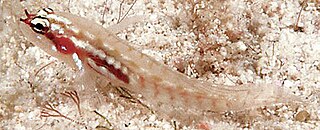
Eviota sigillata, commonly called seven-figure pygmy goby or adorned dwarfgoby, is a species of marine fish in the family Gobiidae. They are widespread throughout the tropical waters of the Indo-West Pacific area, from the Seychelles to the Micronesia.
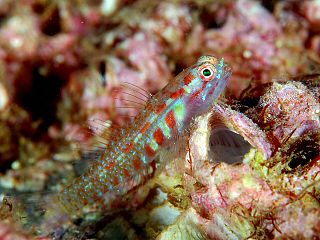
Eviota is a genus of fish in the family Gobiidae, commonly as dwarfgobies found in the Indo-Pacific region, where it is distributed from Japan to Australia and from Africa to Pitcairn Island. Species are mainly associated with coral reefs. Many of these fish are short-lived, with life cycles as brief as 3.5 weeks in the tropics. Some species are hermaphrodites and some representatives live symbiotically among the tentacles of the mushroom coral.

Eviota hoesei, Doug's eviota, is a species of goby associated with reefs and tide pools. It has a limited distribution in the southwest Pacific, being found around New Caledonia, Lord Howe Island, Norfolk Island and the Elizabeth and Middleton Reefs at depths of from 0 to 25 metres. Within this limited area this is an abundant species.
Eviota readerae is a species of goby associated with reefs and tide pools. It has a very limited distribution in the southwest Pacific, being found only on the Elizabeth and Middleton Reefs and the Lord Howe Rise in the Tasman Sea.
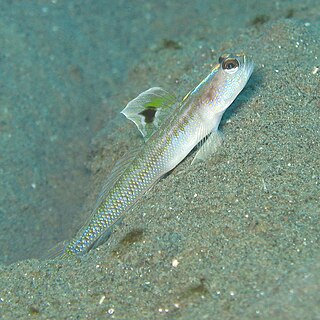
Vanderhorstia is a genus of gobies native to the Indian and Pacific oceans. The name of this genus honours the Dutch biologist Cornelius van der Horst (1889-1951) of the University of the Witwatersrand, Johannesburg, who was well known for his interest in marine biology.
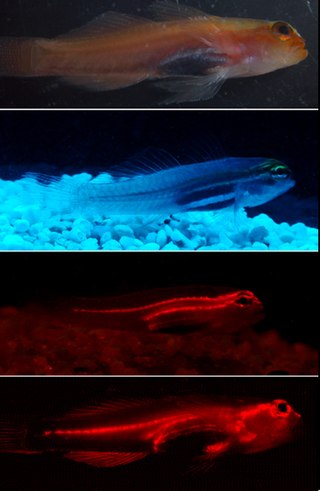
Eviota pellucida, commonly called neon pygmy goby or pellucida pygmy goby, is a species of marine fish in the family Gobiidae.

True gobies were a subfamily, the Gobiinae, of the goby family Gobiidae, although the 5th edition of the Fishes of the World does not subdivide the Gobiidae into subfamilies. They are found in all oceans and a few rivers and lakes, but most live in warm waters. Altogether, the Gobiinae unite about 1149 described species in 160 genera, and new ones are still being discovered in numbers.

Rhinogobius flumineus, commonly known as the lizard goby or kawa-yoshinobori, is a species of goby endemic to Japan where it is found in the mid- to upper reaches of fast-flowing rivers. This species can reach a length of 7 centimetres (2.8 in) TL.

Acanthogobius flavimanus is a species of fish in the goby family known by the common name yellowfin goby. Other common names include mahaze, Japanese river goby, Oriental goby, and spotted goby. It is native to Asia, where its range includes China, Japan, Korea, parts of Russia, Vietnam, and Malaysia. It has spread beyond its native range to become an introduced, and often invasive, species. It has been recorded in Australia, Mexico, and Florida and California in the United States.
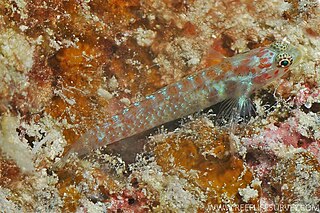
Eviota melasma, commonly called headspot eviota or melasma pygmy goby among various other vernacular names, is a species of marine fish in the family Gobiidae.
Eviota mikiae, commonly called Miki's pygmy-goby or white-line eviota among various other vernacular names, is a species of marine fish in the family Gobiidae.

Trimma nasa, commonly called the nasal dwarfgoby or nasal pygmy goby, is a species of goby from the Western Pacific. They are small fish, averaging at around 2 cm (0.79 in) in length. They are bright orange and transparent yellow in life, with a white stripe running down from between the eyes to the upper lip and a dark brown spot at the base of the tail fin. They are usually found in large schools in the sloping or vertical drop-offs at coral reef edges.
Trimma tevegae, commonly known as the bluestripe pygmygoby or blue-striped cave goby among other names, is a species of goby from the western Pacific. They are small fish, averaging at 2 cm (0.79 in), orange-brown with white undersides in life, with characteristic iridescent blue or lavender stripes on the sides and on top of the body. They are usually found in large schools in the sloping or vertical drop-offs at coral reef edges. They are sometimes caught for the aquarium trade, and are also known by hobbyists under the name blue line flagtail goby. The species is named in honor of the schooner Te Vega.

Goby is a common name for many species of small to medium sized ray-finned fish, normally with large heads and tapered bodies, which are found in marine, brackish and freshwater environments. Traditionally most of the species called gobies have been classified in the order Perciformes as the suborder Gobioidei but in the 5th Edition of Fishes of the World this suborder is elevated to an order Gobiiformes within the clade Percomorpha. Not all the species in the Gobiiformes are referred to as gobies and the "true gobies" are placed in the family Gobiidae, while other species referred to as gobies have been placed in the Oxudercidae. Goby is also used to describe some species which are not classified within the order Gobiiformes, such as the engineer goby or convict blenny Pholidichthys leucotaenia. The word goby derives from the Latin gobius meaning "gudgeon", and some species of goby, especially the sleeper gobies in the family Eleotridae and some of the dartfishes are called "gudgeons", especially in Australia.
Eviota guttata, the spotted dwarfgoby, is a species of ray-finned fish from the family Gobiidae, the "true gobies". It is found in the western Indian Ocean.
Helen K. Larson is an ichthyologist who specialises in the fishes of the Indo-Pacific.
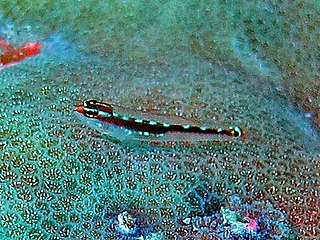
Eviota sebreei, common name Sebree's pygmy goby or striped dwarfgoby, is a species of fishes belonging to the family Gobiidae.
Ernest Albert Lachner was an American ichthyologist with an international reputation for his research on Indo-Pacific gobies and cardinalfishes.













